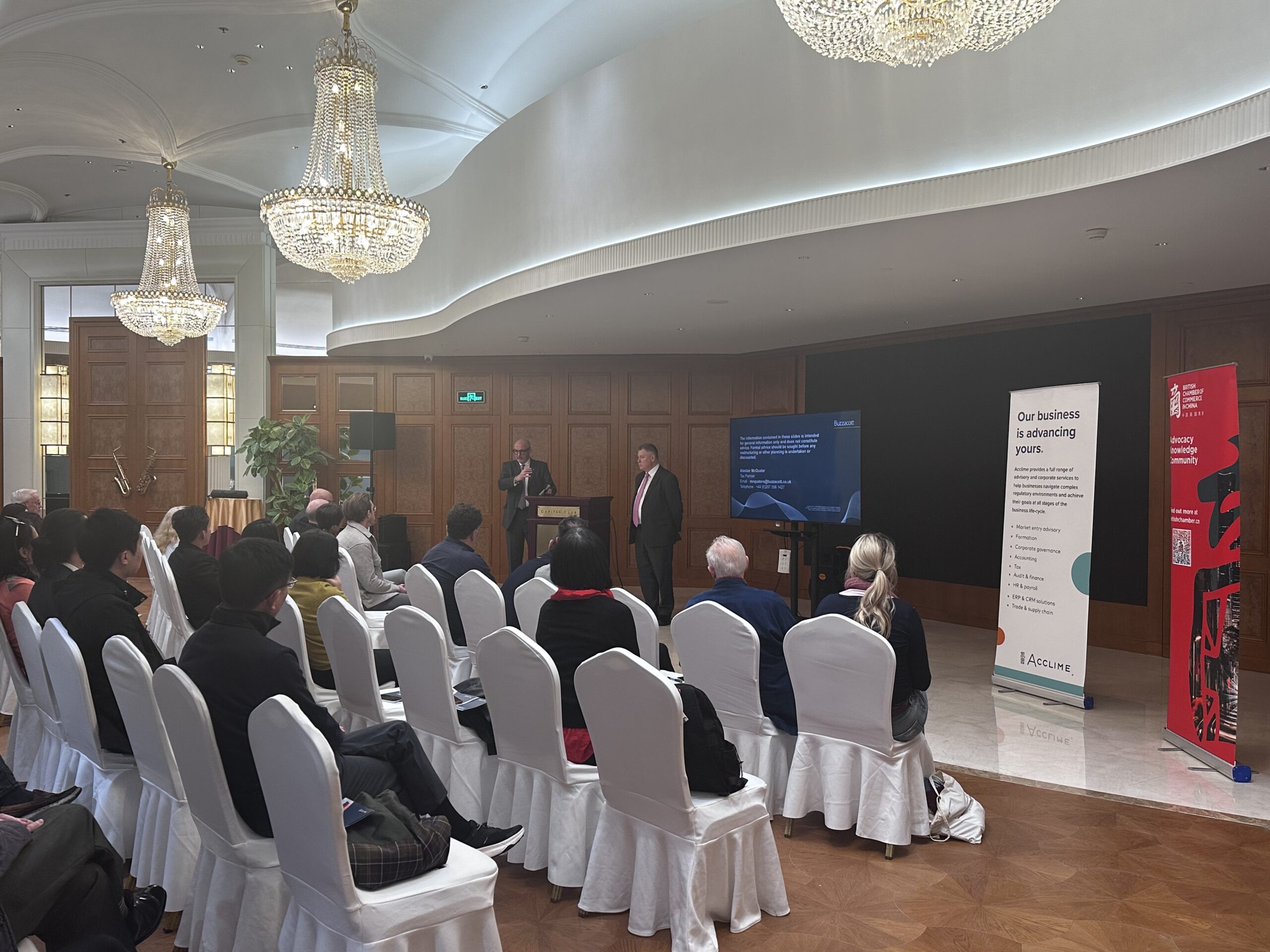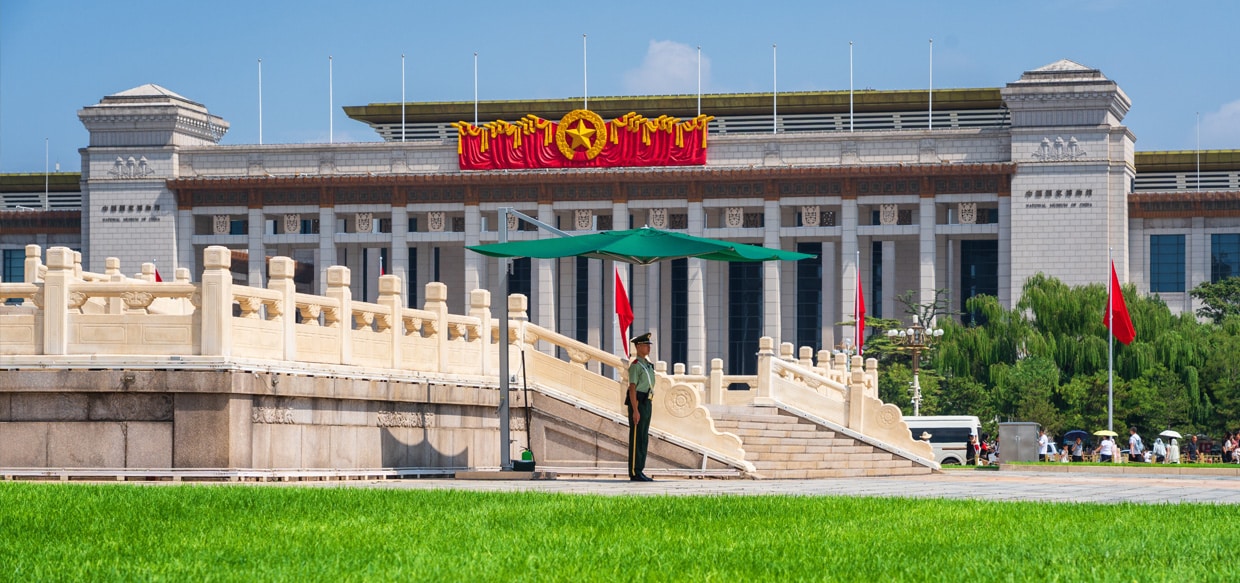With over 30 years of innovation, Reflex Marine is a trusted expert in offshore crew transfer solutions.…

Policy Insight: Two Sessions 2024
Every year, the month of March is punctuated by China’s Two Sessions, or Lianghui. A key political gathering in China, the Lianghui refers to the plenary sessions of China’s National People’s Congress (NPC) and of the Chinese People’s Political Consultative Conference (CPPCC). These key annual sessions offer domestic and global watchers a crucial, if veiled, glance at the main priorities and concerns of China’s top decision-makers.
At Britcham, we’ve scanned speeches, reports and documents to bring you our top insights on the Lianghui. Through four key themes, this Policy Insight assesses what the 2024 Lianghui implies for Chinese political and economic direction in the year ahead.
1 – Macroeconomic targets and policy outcomes: Both policy target and toolkit unchanged?
On the macroeconomic front, boosting growth in the midst of a prolonged period of sluggishness took centre stage at the Lianghui, as signalled by ambitious yet cautious targets. With China policy experts deeming that GDP growth targets were cautiously calculated yet ambitious, Premier Li Qiang’s Government Work Report (GWR) acknowledged explicitly that meeting these targets would “not be an easy task”. Policy outcomes broadly aligned with experts’ and China watchers’ expectations, with the GWR framed as a coherent extension of the December 2023 Central Economic Work Conference (CEWC). The GDP growth target remained unchanged from last year at “around 5%”. This target will be harder to reach than last year owing to a higher basis of comparison. Additional challenges, linked to the wearing off of the initial boom following market opening, are predicted to increase pressures on this front.
While the revival of China’s slowing economic growth undoubtedly remains the most important facet of the 2024 policy agenda, experts highlighted that an equally unchanging policy toolkit means austerity will likely lead the way forward in the coming year. During one of his visits at the Lianghui, Xi emphasised the Party should “motivate the broad masses to rely on their own two hands to create a happy life”, a tacit signal to consumers that there is likely no direct stimulus on the horizon in coming months. The noteworthy resilience of the Chinese economy over the past several months and limited policy capacity are two factors explaining this “underwhelming stimulus”. Minor stimulus to consumption and investment was announced in the form of proposed “trade-in campaigns” which would replace and upgrade used consumer durables and used equipment, for a potential boost of 0.8% to 2024 GDP growth.
Meanwhile, the issuing of 1 trillion renminbi in special central government bonds with “ultra-long” terms signals central government acknowledgement of the challenges faced by debt-ridden local governments. This top-down support should facilitate de-leveraging processes for local governments, highlighting commitment to the sustainable resolution of local debt challenges.
2 – The green transition and economic growth: Two birds of a feather
 Addressing the green transition rose back to the top of the agenda in this year’s Lianghui. In Li Qiang’s GWR, energy and the environment were cited as key priorities on the back of challenges to stay on target for China’s core 2025 climate pledges. Overarchingly, the messaging from this year signalled a commitment to ensure the green transition aligns with sustainable growth, becoming a driver of economic development rather than another cost for society and industry to bear.
Addressing the green transition rose back to the top of the agenda in this year’s Lianghui. In Li Qiang’s GWR, energy and the environment were cited as key priorities on the back of challenges to stay on target for China’s core 2025 climate pledges. Overarchingly, the messaging from this year signalled a commitment to ensure the green transition aligns with sustainable growth, becoming a driver of economic development rather than another cost for society and industry to bear.
Regrettably, emissions from energy in China surged by 5.2% in 2023. This is likely due to increased energy consumption as part of the Covid bounceback, but can also be linked to contemporary impacts of climate change. Indeed, lower rainfall led to greater coal use which supported the electricity demand that hydro-electric power usually provides for. Of the nine main targets for development this year, two focussed on energy and the environment: “a drop of around 2.5% in energy consumption per unit of GDP” and “continued improvements in the environment”. Asia Society experts identified a remarkable lack of quantitative references to future targets and progress in 2023 compared to previous years, reflecting challenges linked to meeting targets and uncertainties as to further progress. Indeed, the aforementioned 2.5% energy intensity reduction has been assessed as an insufficient target if China is still to meet its 13.5% energy intensity reduction as set out in the 14th Five-Year Plan.
How then is China planning to tackle these challenges? This GWR highlighted the development of the national carbon market’s emission trading system (ETS), and its planned expansion to more sectors, likely cement and aluminium. These indicators signal China wishes to align its ETS with EU standards – ensuring compliance with the EU’s Carbon Border Adjustment Mechanism (CBAM) would therefore prevent CBAM’s effects on its exporters.
The Lianghui also highlighted a continued drive to step up renewable capacity, particularly in wind and photovoltaic power, while also providing supportive transmission and energy storage infrastructure. Despite hydrogen’s potentially crucial role to play in the transport sector, the renewable was only briefly mentioned in the work report, highlighting its development is still in the infancy stage and not yet mature enough for profitable commercialisation.
While the pivot towards green growth is reflected in the emphasis on “consolidating and enhancing” China’s leading position in sustainable industries such as those of new-energy vehicles (NEVs), energy and resource security remained enshrined in the report as top priorities. Thermal energy maintained pride of place at the heart of the PRC’s long-term energy plans. Li’s GWR stressed these considerations with mentions of initiatives to step up the exploration and development of oil and natural gas, which currently account for 230 GW and are predicted to increase by 15.3% to 260 GW by the end of 2024 (S&P, 2024). Coal was also emphasised as “crucial” in ensuring economic and social development, and is poised to continue its current role as the main energy supply source. Current coal installed capacity is measured at 1160 GW, yet is due to only increase 3.35% to 1200 GW during 2024. With much lower growth than other energy sectors, this may reflect a progressive pivot away from grey, towards green energy sources (S&P, 2024).
3 – A firm pivot towards “New Productive Forces” – technological and scientific innovation as growth heavyweights
 The 2024 GWR’s emphasis on the term “new productive forces” and “Chinese style modernisation” is noteworthy, reflecting the government’s renewed focus on pivoting towards new drivers of domestic growth in the current context of macroeconomic and geopolitical pressures. Minimising these internal and external vulnerabilities is the key objective underpinning these “new productive forces”, a concept linked to the idea of a “Chinese new growth model” championed as early as 2021. Within this new model, technological innovation, notably in the area of emerging and advanced technologies, has been presented as part of a more diversified, sustainable growth mechanism which is positioned to boost productivity and reinforce self-reliance. With capital diverted from the ailing property sector, state-backed investments into science and technology will seek to further propel the development of these recently designated strategic sectors. In this context, “forward-looking supply-side reforms” are poised to catalyse China’s coveted economic resurgence as well as ensure a long-term global strategic advantage.
The 2024 GWR’s emphasis on the term “new productive forces” and “Chinese style modernisation” is noteworthy, reflecting the government’s renewed focus on pivoting towards new drivers of domestic growth in the current context of macroeconomic and geopolitical pressures. Minimising these internal and external vulnerabilities is the key objective underpinning these “new productive forces”, a concept linked to the idea of a “Chinese new growth model” championed as early as 2021. Within this new model, technological innovation, notably in the area of emerging and advanced technologies, has been presented as part of a more diversified, sustainable growth mechanism which is positioned to boost productivity and reinforce self-reliance. With capital diverted from the ailing property sector, state-backed investments into science and technology will seek to further propel the development of these recently designated strategic sectors. In this context, “forward-looking supply-side reforms” are poised to catalyse China’s coveted economic resurgence as well as ensure a long-term global strategic advantage.
This pivot towards high-tech industry-led growth appears to be riding the tailwinds of China’s initial successes in the globally competitive “new three” industries – solar photovoltaic technologies, lithium batteries and electric vehicles, with renewed focus on hydrogen energy, new materials, creative medecine, biotech, aviation, as well as products linked to the digital economy such as AI+, platform enterprises, big data, cloud computing, block chain and 5G. Moreover, the Lianghui highlighted renewed momentum in upgrading traditional industries, with government support to be offered to businesses becoming “more high-end, more intelligent, and greener”, in the words of President Xi Jinping. In this context, disruptive innovation rather than imitative, “catch-up” development with regards the West appears at the heart of the current political and economic agenda. To drive this initiative, the government will invest 370.8 billion rmb for technological research in the coming fiscal year.
The GWR also highlighted a shifting emphasis on national security as a priority to be balanced in conjunction with economic and technological development, a key signal for the future of the Chinese technology industry. In particular, greater emphasis can be expected on front-tier technology related to national security, such as submarines, aerospace and aircraft carriers.
4 – Warming waters in foreign policy, bids to boost foreign trade and investment
Although the Lianghui primarily provides guidance on China’s domestic policy, with emphasis on economic and social policy, this year’s government report did reflect the increasingly interdependent nature of domestic and foreign policy. Li stated the past year has seen “the external environment [exert] a more adverse impact on China’s development.” The report noted “geopolitical conflicts” were increasingly “acute”, alongside the emergence of greater “protectionism and unilateralism”. Despite this, the Work Report still featured a noteworthy emphasis on greater international involvement. Li emphasised that China is reacting to these emerging risks through its “constructive role in addressing international and regional hotspot issues”. Stabilisation of geopolitical tensions through diplomatic overtures also appears to be on the table, a strategic move likely linked to domestic economic uncertainty. In the Lianghui press conference, Foreign Minister Wang Yi commented there “has been progress in improving relations” with the US in the wake of the Biden-Xi meeting at the Asia-Pacific Economic Cooperation (APEC) forum in November 2023. As suggested by The Diplomat, the Lianghui’s emphasis on global engagement likely reflects this year’s continued shoring up of “its external environment in the interest of domestic stability”.
Associated openness to foreign engagement, specifically trade and foreign direct investment, was another flashpoint of the Lianghui. This was emphasised both in the report and in measures unveiled by the NPC. The latter included a reduction of the FDI negative list, relaxation of market access in service industries, and shelving of investment restrictions in the manufacturing industry. This package of measures and positive rhetoric can be understood as China’s “hit the brakes” reaction to slipping FDI flows – in 2023, FDI flows to China hit a three decade record low. While this bodes well for foreign businesses operating in China, it is likely they will continue to maintain a wait-and-see approach over the coming months to observe how implementation of this high-level reform plays out, alongside stabilisation of the domestic economic environment.



